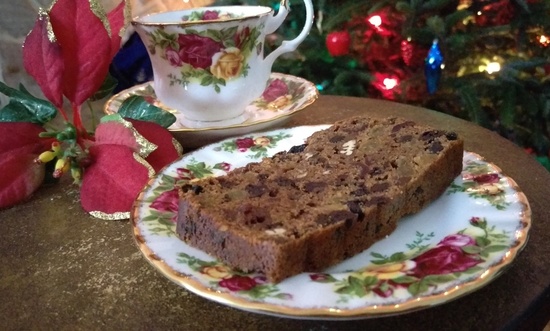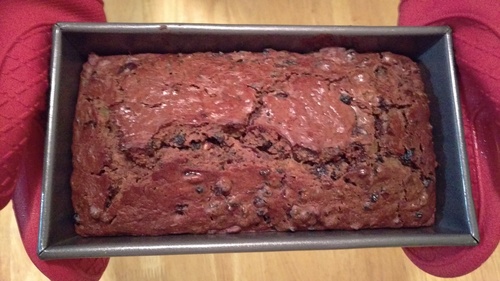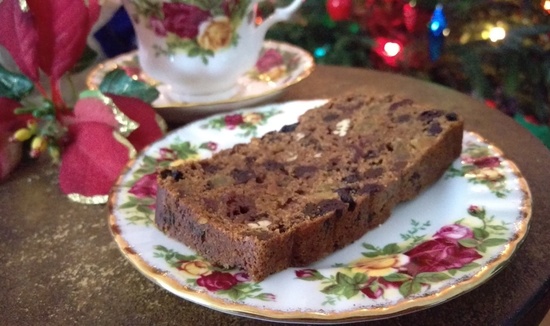
I hate to break it to you, but you’ve probably never had a truly delicious fruitcake before in your life. There’s a reason that fruitcake is a joke and most people hate it, because what has been passed off as fruitcake for roughly the last 80 years is so awful that it shouldn’t be called fruitcake! That cloyingly sweet dense block of glow-in-the-dark neon frankenfruit would give anybody a sore jaw and a stomach ache. This recipe is not that!
Fruitcake has not always been this way. The honorable fruitcake traces its origins to the Middle Ages when European farmers needed a way to preserve fruits through the winter, so they would sun-dry the fruits and bake them into a bread. Sugar was hard to come by in those days, so the sweetness only came from the fruits themselves, or some honey if available. Alcohol was added due to its ability to preserve the cake. Fruitcake has many variations and many names: plum pudding, Christmas cake, Dundee cake, stollen, winterbrot, barmbrack, keks, to name a few.
What most of us in North America know as fruitcake traces back to some southern bakers who massed-produced mail-order cakes with easy access to cheap nuts (which led to the expression “nutty as a fruitcake”). Their liberal use of sub-par, neon colored glacé fruits & citrus peels, and excessive quantities of sugar and molasses, will give anybody a stomach ache just by looking at it. Like the rest of us, I grew up hating fruitcake.
About ten years ago I began, mostly out of curiosity, to experiment with fruit cakes, digging up old family recipes and archaic British cookbooks. I quickly figured out that those glacé fruits that always pop up at the supermarkets in November needed to be eliminated. Glacé is the French word for glazed, and refers to fruits that are preserved in a sugar syrup and then further glazed or candied with syrup. Horrible stuff. I went back to what our ancestors ate: sun dried fruit.
Nearly 10 years of experimentation and refinement, I am sharing with you my recipe for this truly delicious fruitcake. Unfortunately the word fruitcake has been tainted and its not easy to get new people to try it, but I have systematically converted the most staunch haters of fruitcake to now love this recipe. I’ve even been told that I should sell it mail-order (not that again!).
This isn’t the easiest recipe to make, and its not the cheapest. Quality ingredients are vital, and it takes a bit of time and attention to do it right. We want to use entirely natural ingredients, sun dried fruits, fresh spices, honey for sweetness, and quality spirits (rum and brandy). Although we use alcohol, this truly delicious fruitcake doesn’t have even a hint of “booziness” — all of the alcohol will cook and evaporate off.
I suggest that you make this a few weeks before you intend to eat it. By aging it for a couple of weeks the flavors will enhance considerably. Spritzing it with brandy or wrapping in a brandy soaked linen will preserve it for years. (Note: A fruitcake baked in 1878 is being kept by a family in Michigan and is still edible.) I have aged this fruitcake for as much as a year and it was magnificent. If you give this as a gift, be sure to explain to the recipient how lucky they are.
Notes
*Not-reactive means it won't react with acid. Use a pot that is anodized aluminum, stainless steel, stainless lined, non-stick coated, glass, or ceramic. A reactive pot would be copper, tin, raw uncoated aluminum -- don't use these.
Note: It may not seem like very much spice is used here, but because we are freshly grinding them, the potency is so much more intense than stale old pre-ground spices. Always try to source the freshest spices possible!
To serve, slices can be reheated in the microwave for 15 seconds until warm throughout. Serve with butter or a dollop of mascarpone cheese. Delightful!
Ingredients
- 1 cup sun dried currants
- 1 cup sun dried golden raisins
- 1/2 cup sun dried cranberries
- 1/2 cup sun dried cherries
- 1/4 cup sun dried plums, finely chopped
- 3/4 cup sun dried blueberries
- 1/4 cup candied ginger, finely chopped
- zest of one lemon
- zest of one orange
- 1 cup top shelf gold rum (not spiced rum)
- 3/4 cup honey
- 5 ounces unsalted butter (1 1/4 sticks)
- 1 cup fresh unfiltered apple juice (not from concentrate)
- 2 whole peppercorns
- 4 whole cloves
- 6 whole allspice berries
- 1 tsp cinnamon
- 1 tsp ground ginger
- 9 oz flour (or 1 3/4 cups)
- 1 1/2 tsp kosher salt
- 1 tsp baking soda
- 1 tsp baking powder
- 2 large eggs
- 1 cup raw pecans halves (will toast later)
- 1/2 cup top shelf brandy for spritzing
- Special equipment: food-grade spray bottle, 10-inch loaf pan, wooden spoon, Tupperware large enough to hold a whole loaf
Instructions
- Macerate the fruit the night before: combine dried fruits, candied ginger, citrus zest, and rum, into a sealed container and let sit overnight.
- Toast the pecans: preheat the oven to 350 deg F. Spread pecans evenly on a baking sheet. Place in the center rack for 4 minutes. Toss/shake them on the sheet, bake for another 1 minute. Toss/shake them on the sheet, bake for another 1 minute. (A total of 6 minutes) Remove, transfer to a plate, and let cool.
- Grind fresh spices when you are ready to bake: place whole cloves, whole allspice, and whole peppercorns into a cleaned (no coffee grounds) conventional coffee grinder for several minutes until finely ground.
- In a non-reactive* pot, place the macerated fruit with rum, apple juice, honey, freshly ground spices, ground cinnamon, ground ginger, and butter. Bring mixture to a boil stirring often, then reduce heat and simmer for 10 minutes. Remove from heat and cool for 20 minutes.
- Boil a kettle of water (will need it in a few minutes). Preheat oven to 325 deg F.
- Combine flour, salt, soda, and powder, then sift into the fruit mixture (using a sifter or a fine mesh strainer). Using a large wooden spoon combine batter. Stir just enough to combine. Add eggs and pecans. Stir to combine.
- Spoon batter into a greased 10-inch loaf pan. Place a casserole dish on the bottom rack of the oven. Fill casserole dish half-way with boiled water (the steam helps to prevent the fruitcake from drying out). Place loaf pan with fruitcake batter in center rack of oven.
- Bake for one hour. Check for doneness by inserting a knife into the very center of the cake. If comes out clean, its done. If not, bake another 10 minutes and retest. Repeat as needed. (The last part of the cake to be cooked through will be the bottom center.)
- Remove cake from oven and place loaf pan on a cooling rack. Put half cup of brandy into a food grade spray bottle. Spritz the top of the cake. Allow to cool completely before turning out.
- When cake is completely cooled, run a plastic knife along the inside edges of the cake pan, then flip over -- cake should slide out. Spritz all sides with brandy. Place in an air-tight container such as a large Tupperware and keep in a cool, dark, dry place. Every 2-3 days spritz the cake on all sides with brandy. The flavors will enhance daily for several weeks.

Some fun Holiday Traditions which you may want to incorporate into the making of the fruitcake, which goes back to Jolly Olde England:
- when you are mixing the batter, everybody in the family must grab a hold of the wooden spoon and give it a stir together; brings luck to the family for the coming year.
- put a silver coin* in the batter; whoever finds it gets good luck in the coming year. If you chose to do this custom I would urge you to visit a rare coin shop for a solid silver coin, as modern coins are not made with silver and may not bake well (or be food safe).
- put a silver thimble* in the batter; if a bachelorette finds it she will remain a bachelorette for the coming year. As with the dime above, use a pure silver thimble.
- put a silver button* in the batter; if a bachelor find it he will remain a bachelor for the coming year. As above, use a silver button.
*Legal disclaimer: baking metal objects into your cakes may not be safe, may be a choking hazard, and you do so at your own risk. Mommy Perfect and its associates are not responsible for any health consequences that may arise from use of these ancient holiday traditions. These are included here for entertainment and informational purposes only. Use at your own risk.



